Methane is 25 times as potent as carbon dioxide when it comes to trapping heat in the atmosphere, and a single cow can belch 220 pounds of it every year.
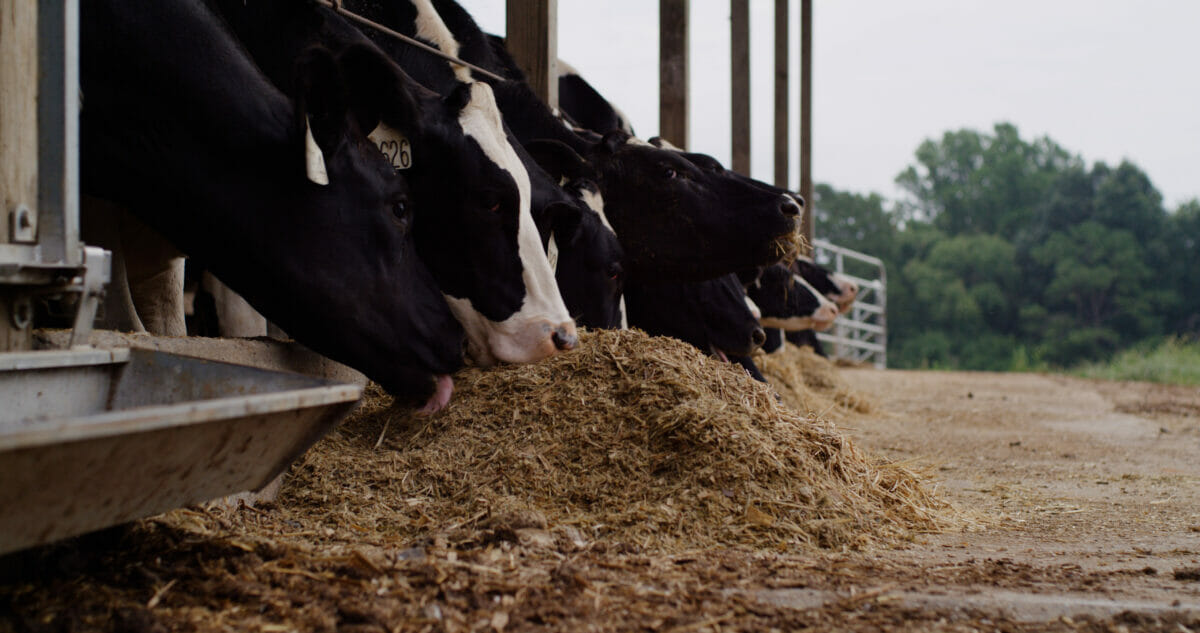
Samantha Craun oversees 1,200 acres and roughly 900 cows at her farm in eastern Tennessee. She took over Davis Brothers Dairy from her father and uncle, and it’s a lot of work. She grows all the forage the cows eat, so between growing her grain and tending to her animals, she’s nearly always busy. But she starts every day the same way: running through data.
“I look at what came in overnight and I make a game plan for the day,” says Craun. “Maybe that’s to move some cows around, like ‘these five cows look like they’re sick.’”
Craun isn’t just documenting which cows look a little peaky through visual inspections alone. She uses rumination collars, which act kind of like an activity tracker for the cows. Similar to how a Fitbit or fitness watch keeps track of your steps or heartbeat, Craun can monitor each cow’s vital stats individually. “We know how many steps she takes in a day. We know what her rumination is for the day—that’s monitored in minutes per day. If she falls below a threshold, we know something’s probably wrong with her and she’s not feeling well,” says Craun. Cows also pant like dogs to cool down, and the collars will record how much panting occurs. “If she has a lot of time panting, then you know she’s not getting cooled off for some reason.”
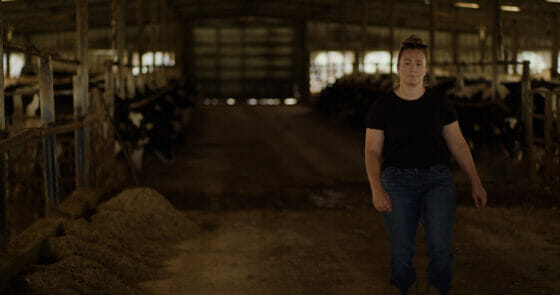
Samantha Craun on her farm. Photography courtesy of The Dairy Alliance.
Craun keeps track of all of these data points for more than just the health of her herd. She’s one of many dairy farmers looking for a way to reduce the amount of methane emitted at her farm. Methane, a greenhouse gas, accounts for about 20 percent of global emissions. It’s also 25 times stronger than carbon dioxide at trapping heat in the atmosphere. Methane contributes to ozone air pollution, and it is linked to one million premature deaths every year. The UN estimates that meeting methane reduction targets would result in fewer hospitalizations and deaths, fewer lost work hours and prevent 25 million tonnes of crop losses. Reducing our methane emissions is crucial to global health.
In the US, agriculture accounts for 25 percent of all methane emissions, with cattle making up more than 85 percent of those emissions. On average, a healthy dairy cow will emit—mostly through burps—about 220 pounds of methane each year.
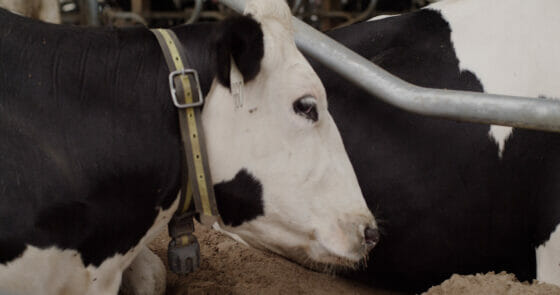
Photography courtesy of The Dairy Alliance.
But there are ways to try and bring that number down, like Craun and her collars. Think of it like this: A dairy cow can produce about seven gallons of milk each day. But as she’s eating and ruminating and milking, that cow is also belching up that methane. So each gallon of milk produced also produces methane.
If a cow gets sick, she might have to go on antibiotics or other medication, which removes her milk from the usable supply for a time. That means she’s still burping away, but her per-gallon emissions are skyrocketing. But if a farmer can catch an illness before it gets to that point, and they can work to prevent that cow getting sick, they’ve just kept their per-gallon emission level steady—and over time, farmers like Craun are hoping those numbers will continue to drop.
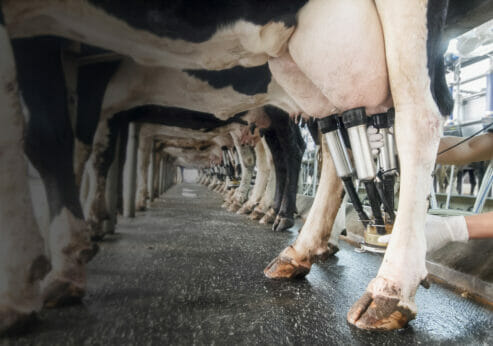
Photography courtesy of smaXtec.
Some farmers are tracking the same kind of data Craun is, but they’re getting even deeper—right into the cow’s stomach. The smaXtec bolus is a small sensor that the cow swallows, and it measures her internal temperature, rumination and water intake. It sends the data to a base station, and then an algorithm analyzes the individual cow’s health, comparing it to the herd as a whole.
Stefan Scherer, CEO of smaXtec, says the technology helps farmers become more proactive, and it gives them the ability to detect diseases about five days before cows develop clinical symptoms. This allows the farmer to support the immune system in other ways, such as using anti-inflammatories or nutritional supplements, without relying on harsher medications. “We can reduce antibiotic usage up to 70 percent…therefore, we make the whole herd more efficient. And the research has proven a 14- or 15-percent methane reduction.”
Of course, there are the cow’s burps, and then there is…the stuff that comes out of the other end. Cow manure is made up of roughly 65 percent methane. In the air around us all the time, methane is a little less than two parts per million. “In a typical dairy barn, it’s about 100 to 200 parts per million,” says Josh Silverman, CEO of Windfall Bio, a startup working to transform that methane into fertilizer. If methane is more prominent inside the barn, it’s the most active near manure lagoons or slurry pits, where many dairy farms pool the waste. “If you go out and look, it’s just bubbling up methane… you might get a few thousand parts per million [of methane] coming off of those manure lagoons.”
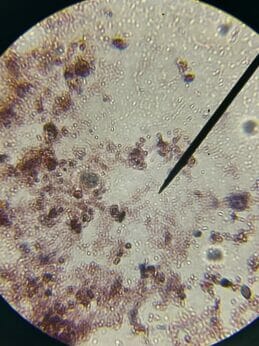
The methane eating microbes under a microscope. Photography courtesy of Windfall Bio.
Silverman aims to turn all that methane right back into nitrogen-rich fertilizer, helping farmers reduce their costs and find a use for a literal waste product. He does that using bacteria called methanotroph, or methane-eating microbes (Windfall Bio is calling them MEMs for short). These MEMs occur naturally in soil, enriching it as they pull methane and nitrogen out of the air and sink it into the ground. “What we’re trying to do is help those farmers close that loop and become more efficient. Right now, if they don’t have a path to capture that methane, they’re just venting it into the atmosphere, because they have nothing else to do with it,” says Silverman. But with MEMs, farmers can get dried and powdered forms of these bacteria (like a packet of yeast that activates when you bake bread) to mix in with their compost pile, making it much more efficient at using up the methane that’s coming off of the existing manure. Silverman says they’re still gathering data, but current models suggest that, over one to two months, the MEMs can double the amount of nitrogen in compost.
“This is really equitable technology. So you don’t have to spend hundreds of thousands of dollars on fancy stainless steel equipment and fans and electricity; this actually works incredibly well down to 10 cow farms [or] 100,000 head farms,” says Silverman.
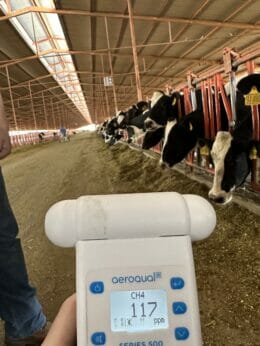
Methane monitor. Photography courtesy of Windfall Bio.
Farmers are already experimenting with other low-tech solutions. Changing up cattle feed to include seaweed or supplements can reduce the amount a cow burps and the methane they expel. Craun pays particular focus on keeping her cows cool, even retrofitting her barn to include soakers: spray nozzles that soak the cows’ backs with water to keep them regulated. “If a cow is hot, she’s stressed,” says Craun. But in the barns with soakers, “it makes a huge difference.” Craun says she’s noticed jumps of more than a gallon of extra milk per day from the cooled-down cows.
The US is one of 100 countries signed on to the Global Methane Pledge; the goal is to reduce methane levels by 30 percent by 2030. It’s necessary to keep global warming to 1.5 degrees, the threshold identified by scientists as crucial to averting the worst outcomes of climate change. Last year, President Biden introduced the Methane Emissions Reduction Action Plan, which, among other programs, pledged $47 million this spring to projects that will mitigate methane emissions. That all sounds good on paper, but the projects are all still in the research phase. Nothing tangible is yet being put into practice at a wide scale.
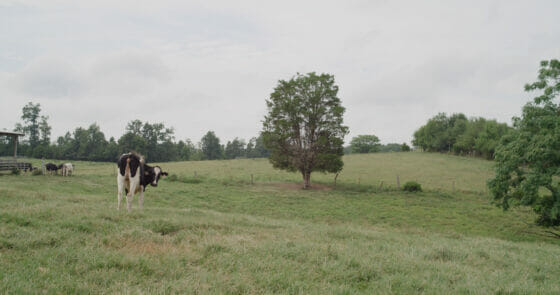
Photography courtesy of The Dairy Alliance.
Ultimately, though, will any of this make a difference? If dairy farms are still producing the same amount of methane for a larger amount of milk, the net environmental impact remains unchanged. There are calls for more stringent taxes and fees on methane emitters. There is also the argument that humans should stop eating beef or drinking milk altogether; that it would be better to remove cattle entirely from the agricultural system. Some research shows that removing cattle from US agriculture would increase food production and decrease agricultural emissions, but not by as much as one would think. In that model, total US greenhouse emissions dropped by only 2.6 percent when cows were excluded from the equation.
The changes the dairy industry is attempting could be viewed through two lenses: Every little bit helps or it’s too little too late. But, unlike carbon dioxide, which sticks around in the atmosphere for hundreds of years, methane can break down in just a decade, which means that practices put into place today could pay off by 2033.
Given that “Methane is 25 times as potent as carbon dioxide when it comes to trapping heat in the atmosphere” How much global warming is it on track to produce by 2100 or in 100 years or if the amount in the atmosphere doubles? If you search the internet for an answer to that question, you will likely come up empty. The answer is: Not very much, so little that it would essentially be unmeasurable, maybe as much as 0.05°C by 2100. If anyone claims it’s more than that, they need to show their work.